Cauliflower, Brassica oleracea var. botrytis, is a cruciferous vegetable that requires consistently cool temperatures, even moisture, good airflow between plants, and nutrient-rich soil to produce firm, compact heads.
Have you read our guide to growing cauliflower?
To recap, when growing this crop, you can gain the upper hand from the start by selecting disease-resistant varieties for planting, and always gardening with clean hands, gloves, and garden footwear to prevent the spread of disease from one plant to another.
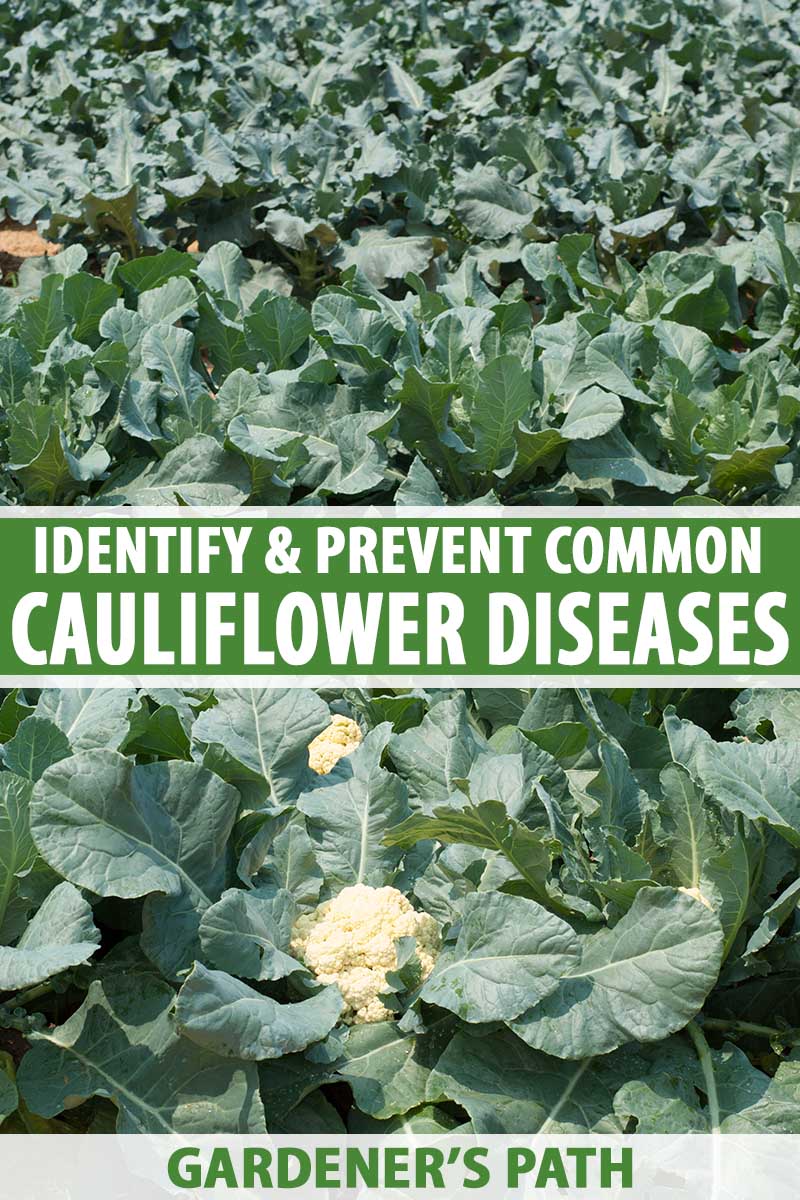
We link to vendors to help you find relevant products. If you buy from one of our links, we may earn a commission.
Always be sure to work with sanitized tools as well, and follow best practices to keep soil moist and well-draining, not oversaturated.
Proper spacing for your selected variety is imperative to provide optimal air circulation, and to prevent the roots of one plant from touching another, which will help to inhibit the spread of disease.
Diligent weeding and removal of plant debris, especially of other brassica varieties, helps to reduce the presence of disease hosts and increase airflow.
And finally, rotate your crops to new locations every season to avoid infection by diseases that winter over when you plant again next season.
Of course, even with diligent and attentive care, problems can sometimes still arise.
In this article, we talk about 12 common cauliflower diseases. You will learn how to avoid, recognize, and address each of them.
Common Cauliflower Diseases
1. Alternaria Leaf Spot
With about 50 species in total in the Alternaria genus, several types, including A. solani and A. brassicicola, can cause leaf spot.
Also known as early leaf blight, this disease affects brassicas such as cauliflower.
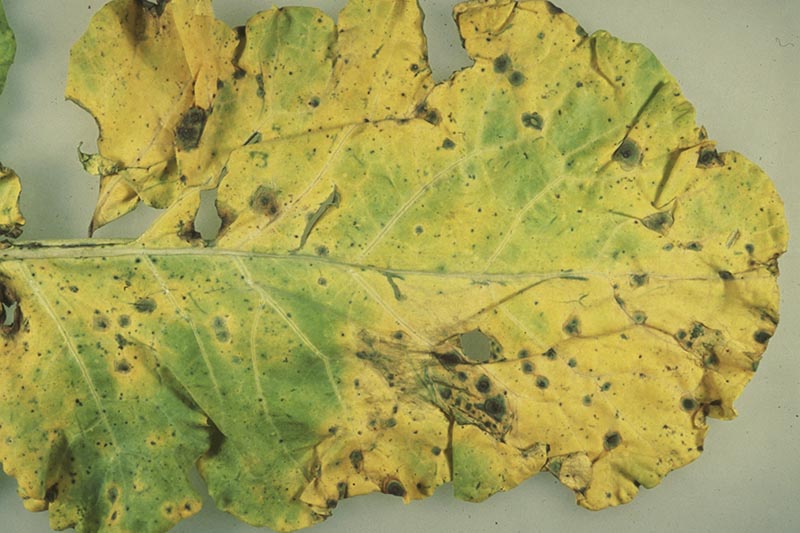
Spores require moisture to germinate. They become active in 60 to 78°F temperatures when conditions are wet, and are transported via wind or splashing water.
Warning Signs of Alternaria Leaf Spot
Telltale signs are brown to black spots with clear margins that look like targets. They usually start on the leaves as individual spots.
When there are enough of them, they merge to form large dead patches that dry up and fall out of the foliage, leaving large holes behind.
Black spots may also form on developing heads.
Defoliation may be limited to just a few leaves, or it can be extensive, affecting the stems and causing plants to weaken and die.
To Avoid Alternaria Leaf Spot
Plant in a full sun location.
Aim the hose or your watering can at the roots, not the leaves, to avoid creating moist conditions on the foliage.
Another proactive step you can take is to drench the soil with a bio-fungicide that contains Trichoderma harzianum at planting time, per package instructions.
This is another type of beneficial fungus that inhibits Alternaria spore germination.
To Address Alternaria Leaf Spot
Snip off affected leaves with clean, sharp pruners and discard them in a sealed bag in the trash.
In the case of a severe infection, apply T. harzianum as a foliar spray per package instructions.
Check out this guide to learn more about how to use Trichoderma in your garden.
2. Bacterial Soft Rot
Bacterial soft rot is caused by several types of virulent bacteria, including Pectobacterium carotovorum.

They attack growing plants by entering tissue through open pores or cracks caused by mechanical injury or insect activity.
Temperatures ranging from 70 to 80°F are favorable for an outbreak, especially if plants are calcium deficient.
Warning Signs of Bacterial Soft Rot
Plants affected by this condition develop soft wet spots on the leaves and/or developing heads that get larger and larger as the plant tissue is broken down by feeding bacteria.
The stems and roots can also be affected. Wilting and discoloration continue until all that remains is a soppy, smelly mess.
This disease may affect harvested crops as well, so always refrigerate what you’ve picked immediately, to avoid temperature fluctuations that may activate bacteria.
To Avoid Bacterial Soft Rot
Use fresh, clean water to maintain even moisture, but do not oversaturate the planting area.
Be careful not to accidentally injure developing plants with weed trimmers or mowers.
Always sanitize garden tools after working on your plants.
To Address Bacterial Soft Rot
Unfortunately, there is no effective treatment for this disease.
Remove affected plants and dispose of them in a sealed bag in the trash.
Learn more about bacterial soft rot in this guide.
3. Blackleg
Blackleg is caused by the fungus Leptosphaeria maculans, aka Phoma lingam, that produces fruiting bodies called pycnidia and pseudothecia.
They contain microscopic spores that are dispersed on the wind when the temperature is between 65 to 80°F and conditions are wet.
The disease may be present in seeds, as well as in plants that develop cracks from especially cold weather, injury, or insect damage.
Warning Signs of Blackleg
The first indications are tan-colored spots on the leaves. Gradually they darken to gray with black dots.
As the disease progresses, the stems may develop lesions, or “cankers,” with dark black to purple margins. The damage may move down the stems to the roots, blackening tissue as it progresses.
To Avoid Blackleg
If seed is not certified disease-free, you may treat it with hot water before planting by soaking seeds for 15 to 30 min at 122°F.
Don’t plant during a wet spell.
Avoid garden activities near plants in damp weather to minimize spore movement.
To Address Blackleg
Remove affected leaves and discard them in a sealed bag in the trash.
You may apply a foliar fungicide; however, it may be of no use if the infection is extensive. In such a case, remove and discard all affected plant material.
4. Black Rot
Black rot is caused by Xanthomonas campestris, a bacterium that likes to feed on susceptible plants when the weather is damp and temperatures are above 77°F.
Warning Signs of Black Rot
The first indications of trouble are yellowing along the margins of the leaves.
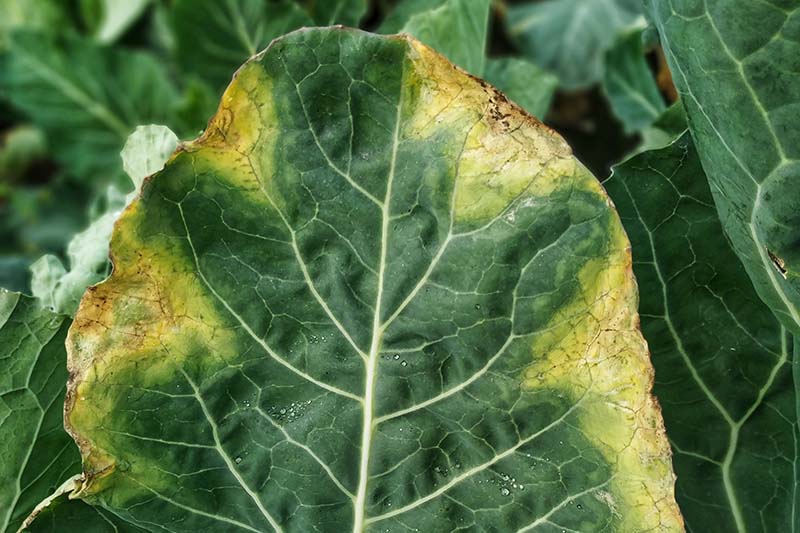
As the discoloration extends towards the center of the leaves, the foliage may dry out and turn brown. In advanced cases, the leaf veins turn black and rot.
The bacteria enter plants via their pores or stomata, and damaged areas that have left plant tissue vulnerable.
To Avoid Black Rot
You can treat seeds that are not certified disease-free by soaking in hot water for 15 minutes at 122°F before planting.
Take care not to injure plants with gardening equipment.
Plant on a dry day and avoid stirring up the garden on wet days.
Keep weeds at bay, particularly those in the mustard family, such as wild mustard and shepherd’s purse.
To Address Black Rot
Immediately remove and discard affected leaves in sealed bags in the trash.
Find detailed guide on controlling black rot here.
5. Cauliflower Mosaic Virus
Cauliflower mosaic virus (CaMV) is a viral disease transmitted by aphids.
Plants are most likely to be affected when temperatures are between 68 and 82°F, when aphids are at their most active.
Warning Signs of Cauliflower Mosaic Virus
“Vein clearing” and an all-over pattern of light and dark green mosaic mottling are the classic symptoms of CaMV.
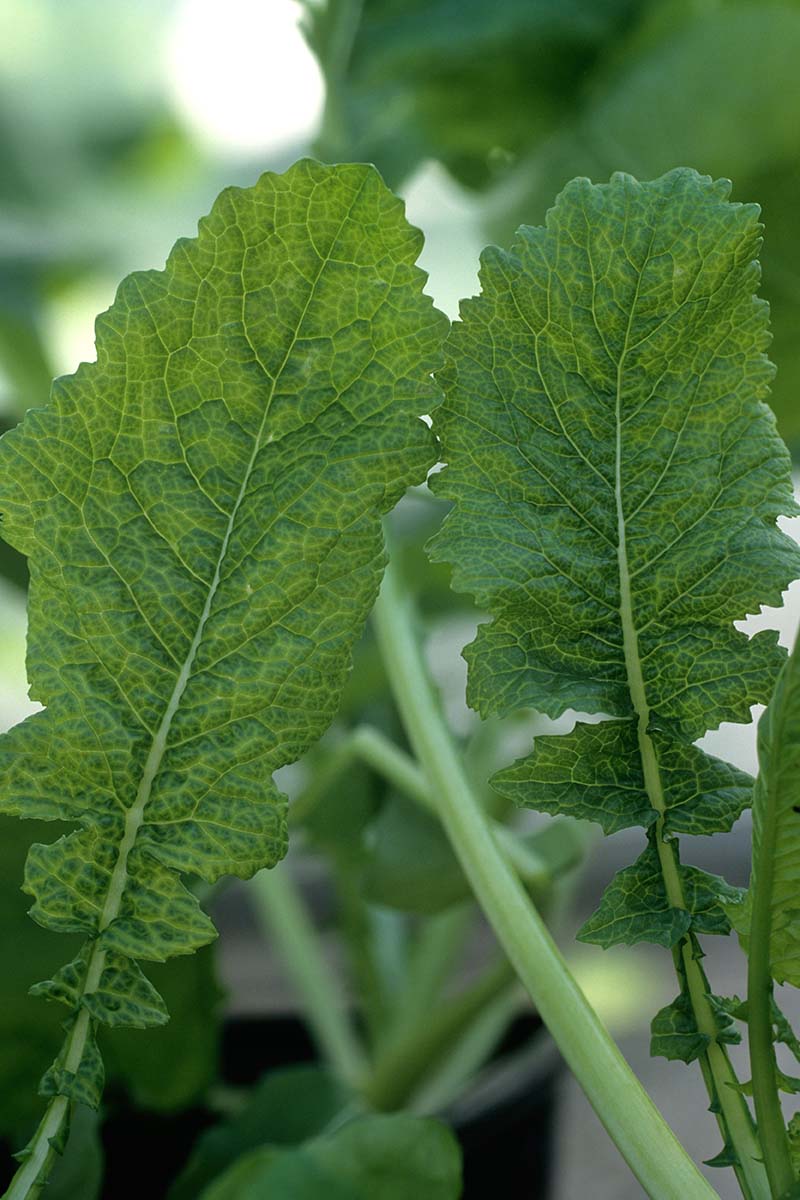
Leaf veins are the target. First, they turn yellow, and then narrow slits appear where there had been veins – this is known as “clearing.”
There may be green lines on the veins, called banding, as well as dry spots of dead tissue on the leaves.
The final identifying characteristic is mosaic-patterned light and dark green mottling of the leaves.
To Avoid Cauliflower Mosaic Virus
Keep the garden free of aphids by interplanting with marigolds, or introducing beneficial predatory insects such as ladybugs to control the population.
To Address Cauliflower Mosaic Virus
Where you see aphids, there’s a risk of CaMV. Aim a hose at them to wash them off plants.
If a strong spray from the hose is not enough, treat plants with neem oil or insecticidal soap per package instructions.
6. Clubroot
Clubroot is caused by a fungus, Plasmodiophora brassica, that lives in the soil, favoring ground temperatures of 73 to 79°F, wet conditions, and acidic soil for activation.
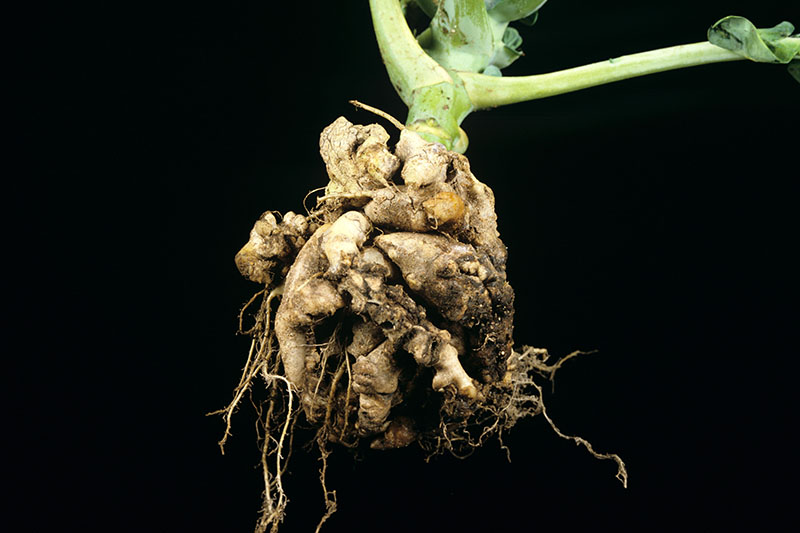
It causes swelling and deformation, or “clubbing” of plant roots.
Warning Signs of Clubroot
Underdeveloped plants with yellow leaves that are prone to wilting may be suffering from clubroot.
To Avoid Clubroot
Conduct a soil test to ascertain its pH level. The ideal range is 6.0 to 7.0.
Adjust it as needed with agricultural lime, which also contains beneficial calcium. Choose either calcitic or dolomitic lime, based on the results of your soil report, as the second type also contains magnesium, which may or may not be necessary.
Plant in cool, dry weather.
To Address Clubroot
Fungicides are not an effective treatment for clubroot.
Remove all affected plant material and dispose of it in a sealed bag in the trash.
7. Damping Off
Damping off is caused by various species of Rhizoctonia fungi and Pythium, a parasitic water mold called oomycete.
This is a soilborne condition that prefers soil temperatures of 75°F and above and wet conditions. The spores germinate when they become airborne and make contact with moisture.
It strikes otherwise healthy seedlings, rotting their leaves, stems, and roots.
Sometimes the attack happens before they have a chance to break ground, and there are no sprouts.
At other times, the seedlings start to grow leaves, when suddenly they are coated with white thread-like webs, their stems become thin like wires, and they fall over dead.
When mature plants are affected, rotting may begin at the roots and works its way up into the stems.
To Avoid Damping Off
Do not plant in wet weather.
Grow plants in a full sun location. Mold-type pathogens prefer dim, damp places.
When starting seeds in containers, be sure to use a quality sterile potting medium and clean containers.
Make sure pots and containers have adequate drainage holes.
To Address Damping Off
There is no treatment for plants that fall victim to the ravages of Pythium. Dispose of affected plants in sealed bags in the trash and sanitize your hand tools.
Learn more about damping off in this guide.
8. Downy Mildew
Downy mildew is caused by Hyaloperonospora parasitica, an oomycete that can damage the foliage and heads of cauliflower. Its spores are carried by the wind and germinate in wet environments with temperatures between 58 and 72°F.
Warning Signs of Downy Mildew
Symptoms include yellow spots on leaf surfaces and furry gray mold underneath. Unchecked, leaves and stems may become deformed and eventually die.
To Avoid Downy Mildew
Irrigate at the soil level to avoid wetting the leaves.
Avoid high-nitrogen fertilizers, as they can promote the growth of H. parasitica.
Preemptive applications of a fungicide containing copper may inhibit downy mildew growth.
To Address Downy Mildew
Remove affected leaves and discard them in sealed bags in the trash. Apply a copper-based fungicide per package instructions.
In the event of widespread disease, remove affected plants and discard them in sealed bags in the trash.
9. Powdery Mildew
Powdery mildew appears as a white, moldy coating on the tops of the leaves.

It is caused by a fungus, Erysiphe cruciferarum, that produces airborne spores that germinate in temperatures ranging from 70 to 80°F and dry conditions with low humidity.
Warning Signs of Powdery Mildew
The first signs of trouble are white blotches on the leaves. Both the tops and undersides may be affected.
The blotches eventually spread to form a fuzzy layer of threadlike mycelia.
As the leaves succumb to the fungus, they turn yellow or brown, at which point other pathogens may invade the infected tissue, leading to rotting and death.
To Avoid Powdery Mildew
Use a balanced fertilizer per package instructions, as too much nitrogen makes plants prone to powdery mildew. Only add extra nitrogen if your soil is deficient.
Apply a sulfur-based fungicide preventively per package instructions.
To Address Powdery Mildew
Pick off affected leaves and discard them in sealed bags in the trash.
Large-scale infection may require the removal and disposal of all affected plants.
10. Ring Spot
Ring spot, aka black blight, is caused by Mycosphaerella brassicicola, an ascomycete, which is a type of sac fungus.

Spores reproduce from sac-like structures, forming minute “fruiting bodies” that require temperatures of 59 to 70°F and damp conditions to germinate.
Ring spot may originate in the seed itself, or infect the plant through its stomata.
Warning Signs of Ring Spot
If the foliage has brownish lesions with yellowish margins, and a bull’s-eye appearance, fungal colonization may be underway. Unchecked, the blemishes join together and blacken the leaves.
Both leaves and stems may be affected.
To Avoid Ring Spot
You can heat treat seeds that are not certified disease-free for 30 minutes at 122°F prior to sowing.
Apply a preemptive fungicide that contains Chlorothalonil, an organic, non-systemic compound.
To Address Ring Spot
At the first sign of disease, remove affected foliage.
For a minor infection, apply a Chlorothalonil-based fungicide, according to package instructions.
Extensive damage may require disposal of entire plants in sealed bags in the trash.
11. Sclerotinia Stem Rot
Stem rot, aka white mold or white blight, is caused by Sclerotinia sclerotiorum, another ascomycete or sac fungus.
Spores germinate when temperatures are between 54 and 75°F, with high humidity and water-soaked soil.
It disperses pathogenic spores called ascospores that wreak havoc on roots, foliage, and heads.
Warning Signs of Sclerotinia Stem Rot
You may notice the fruiting bodies growing underneath the leaves after a heavy rain that has soaked the soil.

Soon there will be soggy abrasions in the stems and/or leaves, followed by white threadlike growths called mycelia.
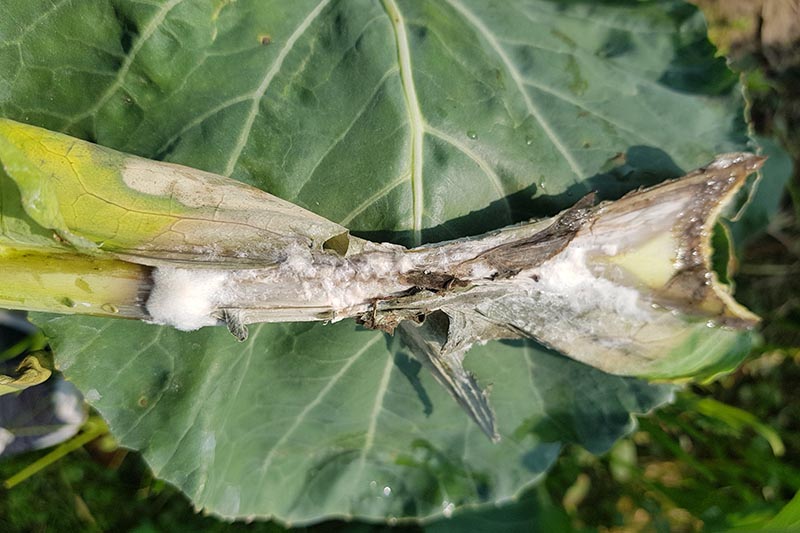
The mycelia eventually become furry looking, and turn gray. The sclerotia form in the mycelia, starting out white and then turning black and hard.
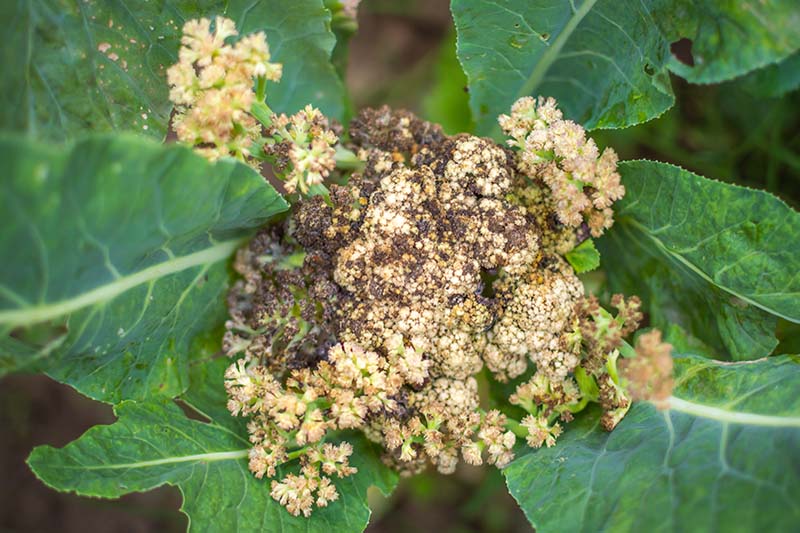
Affected stems and leaves wilt and turn white, and heads turn gray or black before dying.
To Avoid Sclerotinia Stem Rot
Plant in full sun to inhibit moisture buildup.
Mulch with organic material like compost to increase the activity of microbes in the soil and inhibit Sclerotinia germination.
To Address Sclerotinia Stem Rot
You can apply a systemic biofungicide that contains the microparasite Coniothyrium minitans prior to planting, per package instructions, to prevent sclerotia from germinating.
12. White Rust
White rust, aka white blister, is caused by Albugo candida, a water mold parasite, or oomycete, with especially thick-walled spores called oospores that germinate in cool, damp, and humid environments.
Warning Signs of White Rust
The first indications of disease may be chlorosis, evidenced by yellow blotches on the leaf surfaces.
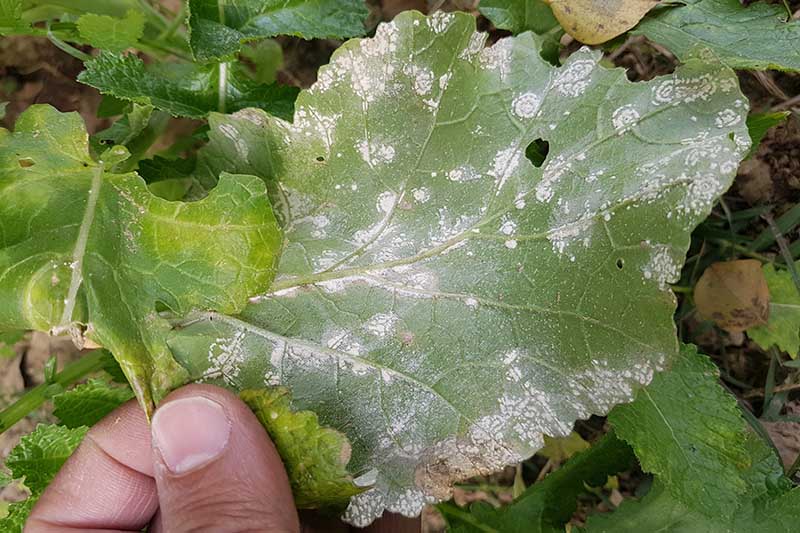
Meanwhile, on the undersides of the leaves, a moldy layer of raised, powdery white bumps forms. When the white bumps release spores, the yellow patches on top of the leaf turn brown, and the leaf begins to die.
To Prevent White Rust
Plant in a location with full sun.
Water at the soil level to avoid wetting foliage.
Apply a systemic fungicide preemptively. Those containing Metalaxyl, a benzenoid, are most likely to inhibit white rust germination.
To Address White Rust
Pick off affected leaves.
Large-scale infection requires the removal and disposal of plants in sealed bags in the trash.
Neem oil or a sulfur-based fungicide may work at the first sign of disease, but generally won’t help plants already seriously affected, as the pathogen that causes white rust quickly becomes resistant to treatment.
Remove and dispose of grossly affected plants in sealed bags in the trash.
Ready to Grow
With a reputation for being a finicky plant that’s challenging to grow, it’s important to remember that with the right growing conditions, you can avoid most of the problems described above.
Disease-resistant and certified disease-free cultivars, cool temperatures, even moisture, good airflow, and nutrient-rich soil go a long way toward ensuring good plant health.
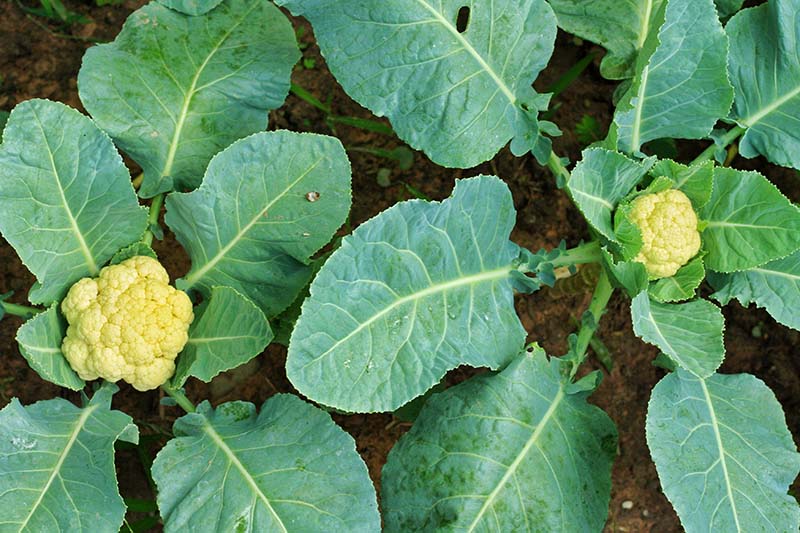
And with an understanding of 12 common diseases, you can use proactive measures to avoid trouble, and recognize issues in time to take action.
Have you experienced any of these diseases on your crops? Let us know in the comments below!
And for more information about growing cauliflower in your garden, check out these guides next:
- How to Grow Cauliflower in Containers
- 9 Cauliflower Head Disorders and How to Avoid Them
- 11 Reasons Why Your Cauliflower May Not Form Heads
- Why Is My Cauliflower Turning Purple?
© Ask the Experts, LLC. ALL RIGHTS RESERVED. See our TOS for more details. Uncredited photos: Shutterstock.
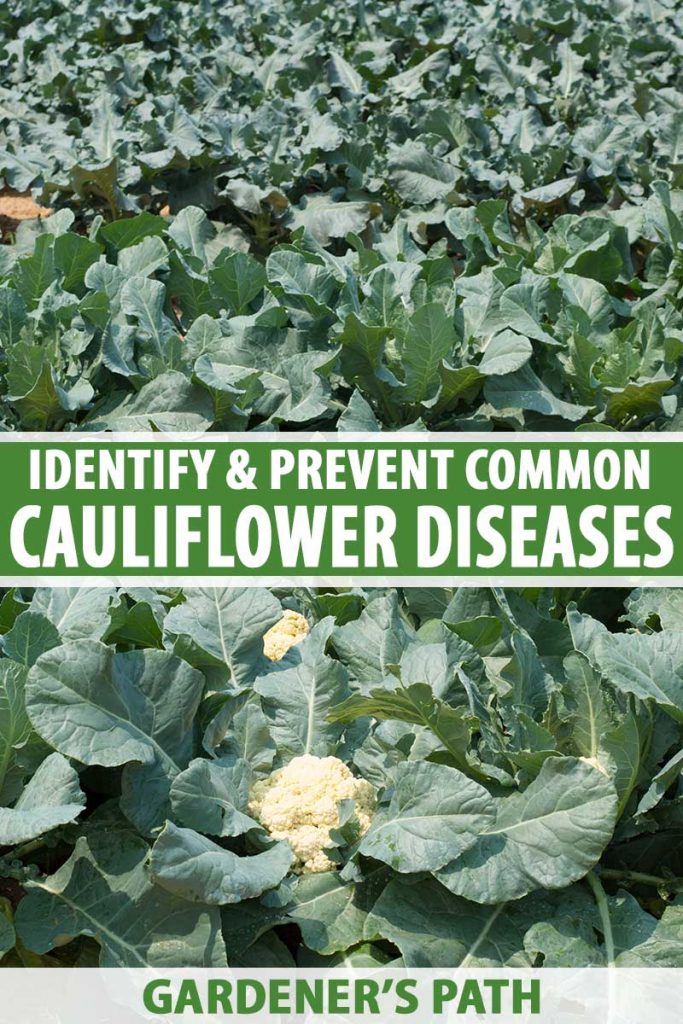



molbydenium deficiency in cauliflower.